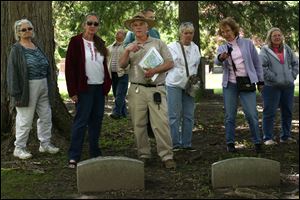
Woodlawn Cemetery tours rich in history
‘The story of Toledo’ is told by tombstones
5/19/2014
Architect Rob Lamlein, center left, explains a sarcophagus during a walk through Historic Woodlawn Cemetery on Sunday in West Toledo. The cemetery has 77,000 people interred on its grounds.
Trees and tombstones were the unofficial theme Sunday as Historic Woodlawn Cemetery held the first of its semiannual guided walking tours for 2014.
The elegant grounds on Central Avenue, with more than 100 varieties of hardwoods, contain many of the names behind Toledo’s storied industrial and commercial history, such as Babcock, Bostwick, Ketcham, Ludwig, Secor, Spitzer, and Stranahan, to name a few.
“The story of Toledo is here, in the names of the people whose names we see on the tombstones,” said Mimi Malcolm, who was among the 15 tour-goers and knows the cemetery well as an amateur genealogist. “My family is buried here in section 4. They were some of the earliest people buried here, in the 1880s.”
Historic Woodlawn, which dates to 1876, is a private, nonprofit, nondenominational cemetery. Its more than 160 acres comprise rolling hills and a lake, with more than 40 acres of burial space available.
Woodlawn averages five to eight burials per week and has about 77,000 people interred there, including former U.S. Supreme Court Chief Justice Morrison Waite, and former Postmaster General Walter Brown.
Guide Rob Lamlein, an architect by training, said Woodlawn was laid out in conformance with the Rural Cemetery Movement, which originated in England and sought to make the cemetery an encounter with nature. The movement eschewed Gothic styles as reminiscent of the Church of Rome and Vatican.
And as in real estate, the rule at Woodlawn was location, Mr. Lamlein said. The choicest burial sites were along the main road, where the grand tombstones, mausoleums, sarcophagi, and obelisks, with their graven family names, were seen by funeral-goers.
“For the upper classes, it was quite an experience,” he explained.
Mr. Lamlein showed the Romanesque influences on many of the sarcophagi, including dentils, scrolls, roses, and bay and acanthus leaves. Patricia Toneff, Woodlawn’s associate director, stopped the group below a large tulip poplar, which in fact is a member of the magnolia family, she said.
“It’s called a tulip tree because it has gorgeous flowers,” she explained. “The big blooms have nectar for pollinators, and the tree has beautiful yellow colors in the fall.”
Wendy Ridley, another tour-goer, has a special connection to Woodlawn because her late mother, Jessie Lewis, was buried there two years ago. “I have a plot by her, and so do my brothers and my kids,” she said.
Contact Carl Ryan at: carlryan@theblade.com or 419-724-6095.